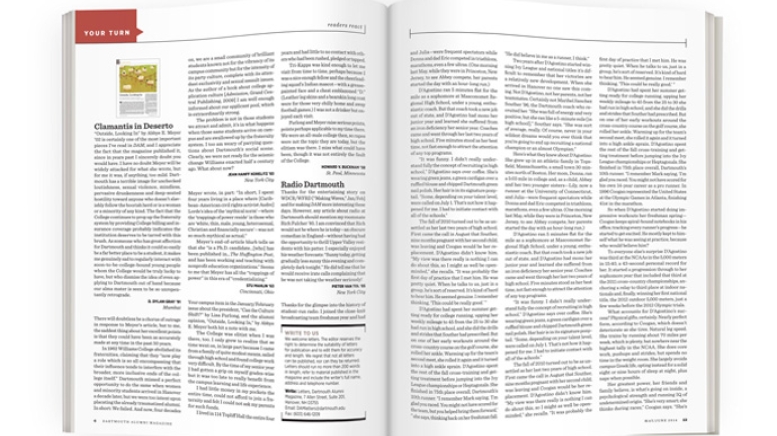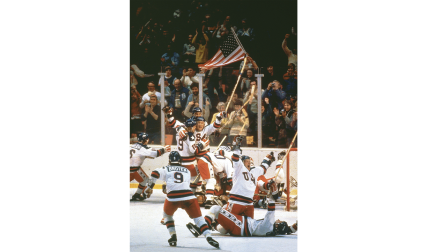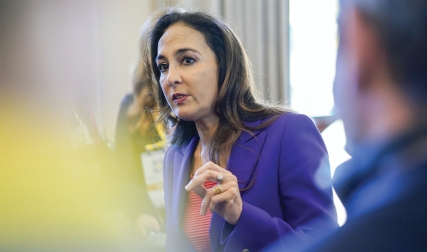Clamantis in Deserto
“Outside, Looking In” by Abbye E. Meyer ’02 is certainly one of the most important pieces I’ve read in DAM, and I appreciate the fact that the magazine published it, since in years past I sincerely doubt you would have. I have no doubt Meyer will be widely attacked for what she wrote, but for me it was, if anything, too mild. Dartmouth has a terrible image for unchecked loutishness, sexual violence, mindless, pervasive drunkenness and deep-seated hostility toward anyone who doesn’t slavishly follow the boorish herd or is a woman or a minority of any kind. The fact that the College continues to prop up the fraternity system by providing College billing and insurance coverage probably indicates the institution deserves to be tarred with this brush. As someone who has great affection for Dartmouth and thinks it could so easily be a far better place to be a student, it makes me genuinely sad to regularly interact with soon-to-be-college-bound young people whom the College would be truly lucky to have, but who dismiss the idea of even applying to Dartmouth out of hand because our alma mater is seen to be so unrepentantly retrograde.
D. Dylan Gray ’91
Mumbai
There will doubtless be a chorus of outrage in response to Meyer’s article, but to me, the saddest thing about her excellent points is that they could have been as accurately made at any time in the past 50 years.
In 1962 Williams College abolished its fraternities, claiming that they “now play a role which is so all encompassing that their influence tends to interfere with the broader, more inclusive ends of the college itself.” Dartmouth missed a perfect opportunity to do the same when women and minority students arrived in Hanover a decade later, but we were too intent upon placating the already traumatized alumni. In short: We failed. And now, four decades on, we are a small community of brilliant students known not for the vibrancy of its campus community but for the intensity of its party culture, complete with its attendant exclusivity and sexual assault issues. As the author of a book about college application culture [Admission, Grand Central Publishing, 2009] I am well enough informed about our applicant pool, which is extraordinarily strong.
The problem is not in those students we attract and admit, it’s in what happens when those same students arrive on campus and are swallowed up by the fraternity system. I too am weary of parrying questions about Dartmouth’s social scene. Clearly, we were not ready for the seismic change Williams enacted half a century ago. What about now?
Jean Hanff Korelitz ’83
New York City
Meyer wrote, in part: “In short, I spent four years living in a place where [Caribbean-American civil rights activist Audre] Lorde’s idea of the ‘mythical norm’—where the ‘trappings of power reside’ in those who are ‘white, thin, male, young, heterosexual, Christian and financially secure’—was not so much mythical as actual.”
Meyer’s end-of-article blurb tells us that she “is a Ph.D. candidate…[who] has been published in…The Huffington Post, and has been working and teaching with nonprofit education organizations.” Seems to me that Meyer has all the “trappings of power” in this era of “credentializing.”
Stu Mahlin ’63
Cincinnati, Ohio
Your campus item in the January/February issue about the president, “Can the Culture Shift?” by Lisa Furlong, and the alumni opinion, “Outside, Looking In” by Abbye E. Meyer, both hit a note with me.
The College was elitist when I was there, too. I only grew to realize that as time went on, in large part because I came from a family of quite modest means, sailed through high school and found college work very difficult. By the time of my senior year I had gotten a grip on myself grades-wise but it was too late to really benefit from the campus learning and life experience.
I had little money in my pockets the entire time, could not afford to join a fraternity and felt I could not ask my parents for such funds.
I lived in 114 Topliff Hall the entire four years and had little to no contact with others who had been rushed, pledged or tapped.
Tri-Kappa was kind enough to let me visit from time to time, perhaps because I was a nice enough fellow and the cheerleading squad’s Indian mascot—with a grease-painted face and a chest emblazoned “D.” (Leather leg skins and a bearskin long coat were for those very chilly home and away football games.) I was not a drinker but enjoyed each visit.
Furlong and Meyer raise serious points, points perhaps applicable to my time there. We were an all-male college then, so rapes were not the topic they are today, but the elitism was there. I miss what could have been, though it was not entirely the fault of the College.
Howard V. Bucknam ’58
St. Paul, Minnesota
Radio Dartmouth
Thanks for the entertaining story on WDCR/WFRD [“Making Waves,” Jan/Feb] and for making DAM more interesting these days. However, any article about radio at Dartmouth should mention my roommate Rich Fulcher ’85. I am convinced that Rich would not be where he is today—an obscure comedian in England—without having had the opportunity to thrill Upper Valley residents with his patter. I especially enjoyed his weather forecasts: “Sunny today, getting gradually less sunny this evening and completely dark tonight.” He did tell me that he would receive irate calls complaining that he was not taking the weather seriously!
Pieter Van Tol ’85
New York City
Thanks for the glimpse into the history of student-run radio. I joined the close-knit broadcasting team freshman year and had a lot of fun hosting a jazz show, a New Wave show (I could count the listeners on one hand) and a long-running classical show on Sundays, when nobody else wanted to spin Vivaldi records. Remarkably, the latter experience served me well in my career as a development consultant to symphony orchestras, since I had figured out how to pronounce (on-air, gulp!) virtually every composer and conductor in the field. Sometimes you learn the most useful things in the most unexpected places.
Ron den Broeder ’85
King of Prussia, Pennsylvania
I enjoyed working at WDBS. The late John Gambling ’51 was the station manager when I joined, his father being the John Gambling of Rambling with Gambling morning radio in N.Y.C. I joined in 1951 and became sports director in 1953 and 1954. As such I traveled to away football games including West Point, doing remotes with partners including Jim Rill ’54. At that point Army was the tops! I did many memorable interviews, among them those with Barbara Ann Scott, the Olympic figure skater, and Pete Geithner ’54, our basketball captain and father of Tim Geithner ’83, former secretary of the U.S. Treasury. Also did some AM DJ shows along with Herb Solow ’53, Bill Gitt ’53 and Dave Dugan ’52.
Larry Russell ’54
Alpharetta, Georgia
Peak Performance
I just read four recent issues of your magazine while reducing my pile of unread journals. When did you become so DAMned good? (Sorry, couldn’t resist.) The printing is sharp, the layout inviting, the article selection excellent and the writing is as good as I have seen anywhere. The story about Mount Everest climber Barry Corbett ’58 [“Second Chapter,” July/Aug 2013] was incredibly touching and in many ways, at least for people my age, quintessentially Dartmouth. I’ll have to put you on the top of the pile henceforth.
Josh Fitzhugh ’70
West Berlin, Vermont
Going for Gold
I enjoyed reading “The Contenders” [Jan/Feb]. Dartmouth has a great group of athletes. However, you omitted at least one Olympic hopeful for the Sochi Games. Michael Ankeny ’13, son of Becky Wolcott Ankeny ’83 and Chuck Ankeny ’83, is currently on the U.S. alpine ski team and has been for five years.
He specializes in slalom and giant slalom. He had a recent first-place finish in an FIS race in Chamonix, France, and placed third in a 2013 NorAm giant slalom race.
Kim Maletta Shibley ’84
Wayzata, Minnesota
It Wasn’t Easy
“Strangers in a Strange Land” [Nov/Dec 2013] brought back some intense memories. It was a snowy fall morning in 1970 when friend Hollis White ’74 and I saw a young woman pushed out the door of a frat, barefoot and wearing a light cotton granny dress. A big frat boy opened an upper-level window and hurled a pair of shoes into the snowbank near her. We were incredulous but later learned this was typical. Girls from nearby women’s colleges were bused in on Friday nights, used, then bused back on Sunday.
Dartmouth was then experimenting with its recommitment to educating Native Americans and with coeducation. A transfer from Oberlin, I was among that first group of 20 Native students and the first group of 80 women on campus—the first Native American woman to attend the College.
Breaking the “Buckskin Barrier” was tough, but we were fearless for each other’s sake. I had met some of the guys before through the A Better Chance program and Organization of Native American Students. Drew Ryce ’74 got it right in your interview: As a tradition-bound institution, Dartmouth didn’t want to deal with Native issues, didn’t want women, minorities or new programs. We protested the Indian symbol, we protested the Hovey Grill drunken Indian mural, we confronted deans about the language requirement, we barricaded an expelled Native student in the dorm, we demanded curricular changes, we questioned the leadership assigned to us.
After that first year I believe most of us suffered from some form of post-traumatic stress disorder. I recovered through a sweat-lodge ceremony and dedication to a 40-year career in higher education and educational outreach; Hollis, my husband of 40 years, through writing an unpublished novel about the experience, his gifts as a naturalist and work in tribal programs.
There are many happy endings in the achievements and accomplishments of the Native American students whose lives have been touched by Dartmouth and who have a deep sense of pride in their connection with this remarkable institution that has embraced the Native American program and coeducation.
Denise Deane White
Akwesasne, New York
Painted Into a Corner
Thank you for the January/February issue. As always, there is much good reading therein. Please clarify one aspect of the story by Rianna P. Starheim ’14 about Cab Miller’s goalie mask [“Campus”]: a great work of art that reflects his unique perspective and experience.
The story says, “The team covers the expense.” Is the $600 additional cost to paint the helmet truly paid for by the College? I assumed that Miller bore the expense of this lovely, but superfluous addition to his game equipment. As a modest donor to the annual fund for the past 30 years, I wondered at the thought that my entire annual gift could be devoted to the painting of Miller’s mask. Perhaps the funding comes out of a specific donor’s direct gift to the hockey program and not out of the general operating expenses of the College. However, if Miller retains possession of the mask, would that amount be a direct payment to an individual player contrary to NCAA regulations? Either way, the $600 could be spent or saved by the College for other purposes consistent with Dartmouth’s mission. Given the oft-stated desire to stem the rising tide of increasing costs of higher education, cutting back on small luxuries would be a good step.
Please clarify this matter, because there is probably a sensible explanation that will allay my concerns. Absent such a logical explanation, it might make more sense for student-athletes who choose to individualize their gear to pay for it out of their own pockets. Miller might choose to simply wear a helmet painted in glorious Dartmouth green—saving the College and himself some of the ordinary green stuff for other purposes.
Peter Gunn ’84
Easthampton, Massachusetts
Editor’s Note: Dartmouth Athletics informs us that the provision of painted goalie masks, which is standard in Division I college hockey, is fully compliant with NCAA rules and is funded by gifts earmarked for the hockey programs, not by the College’s operating budget.




